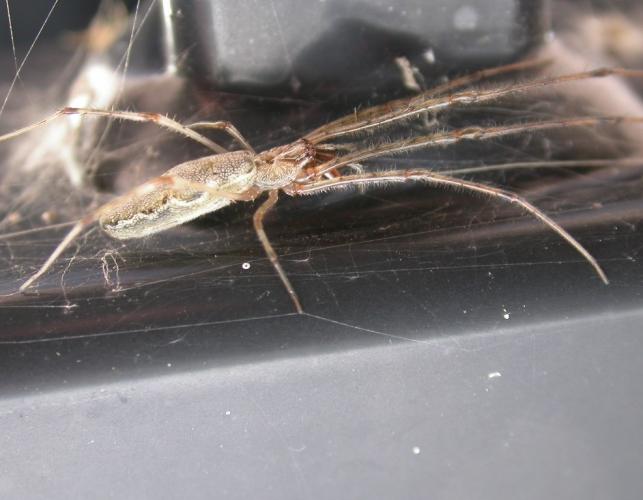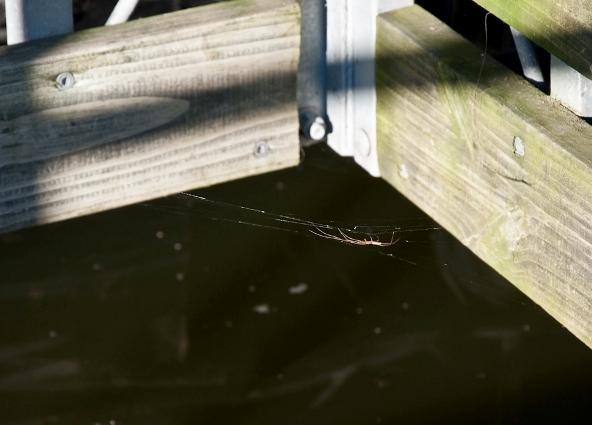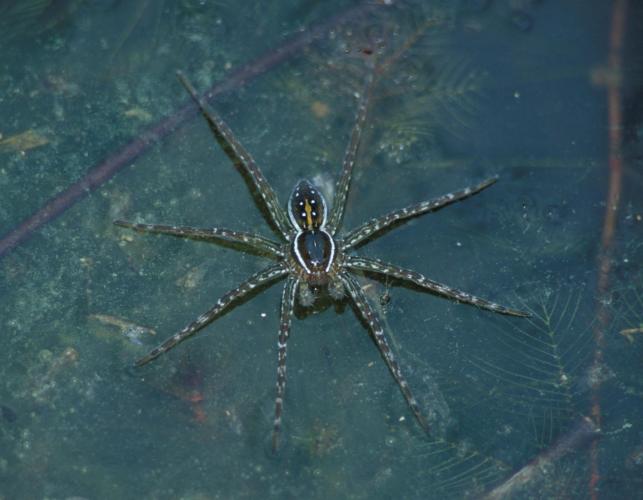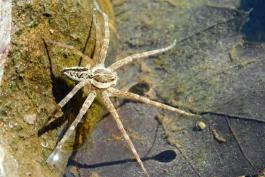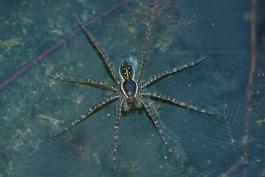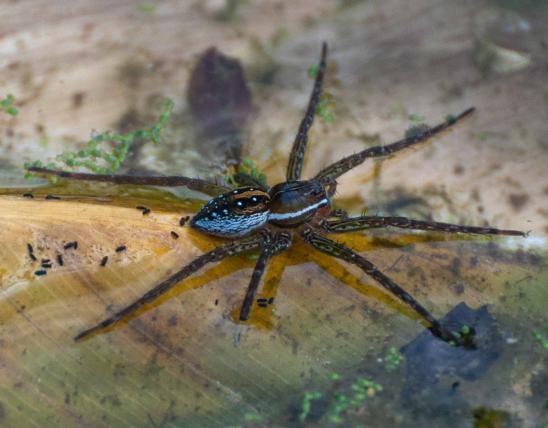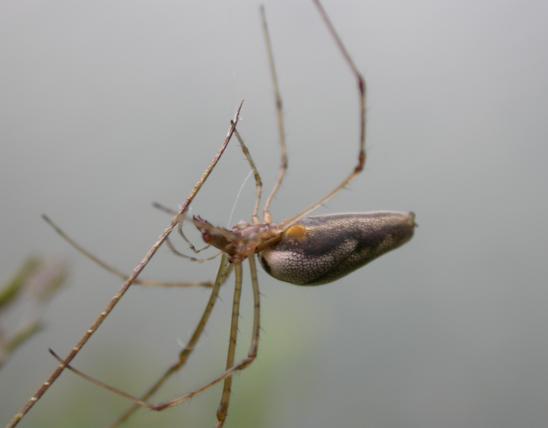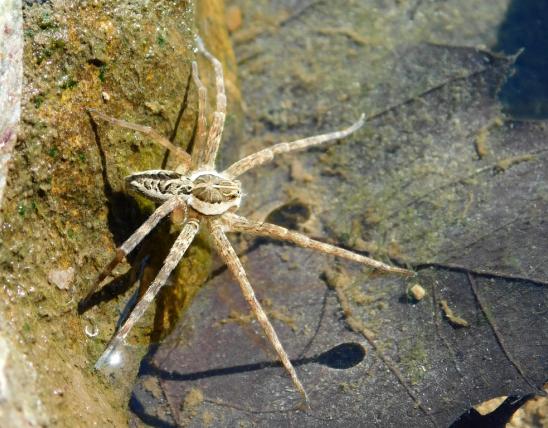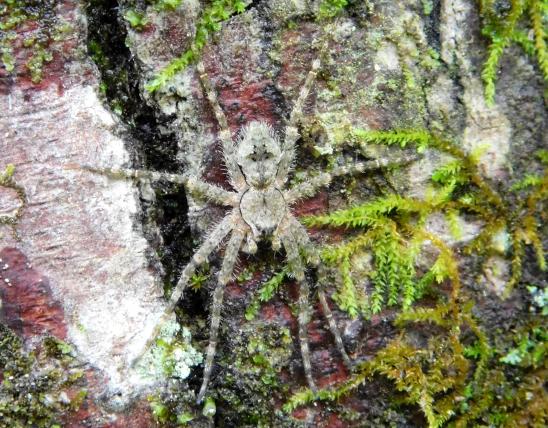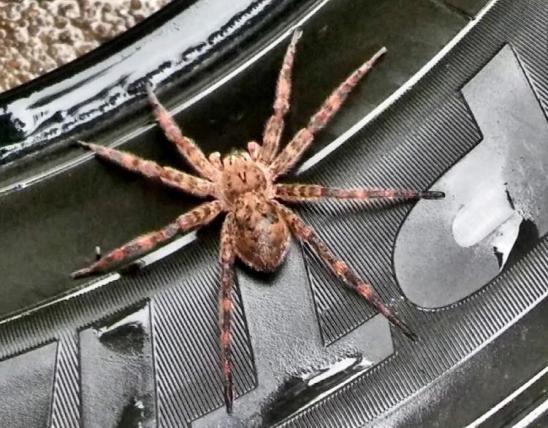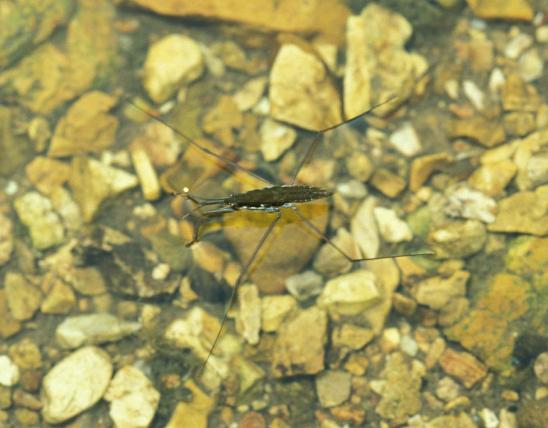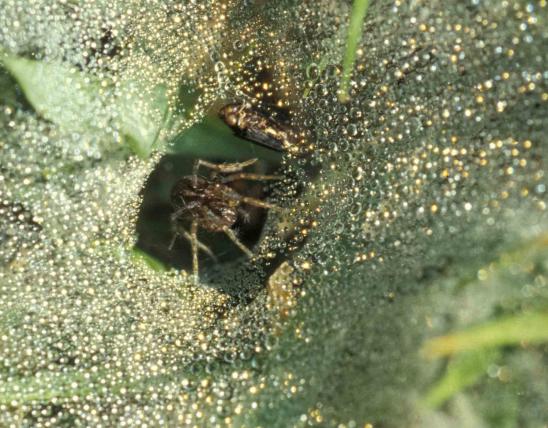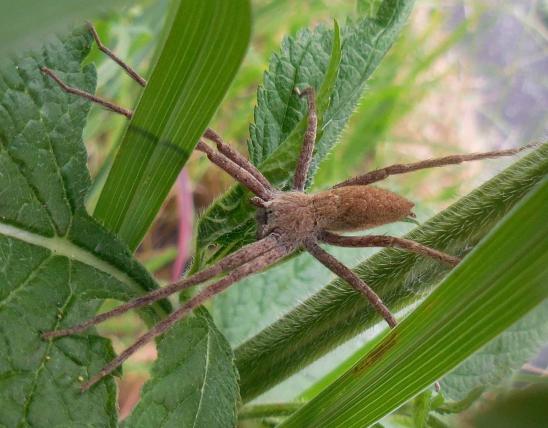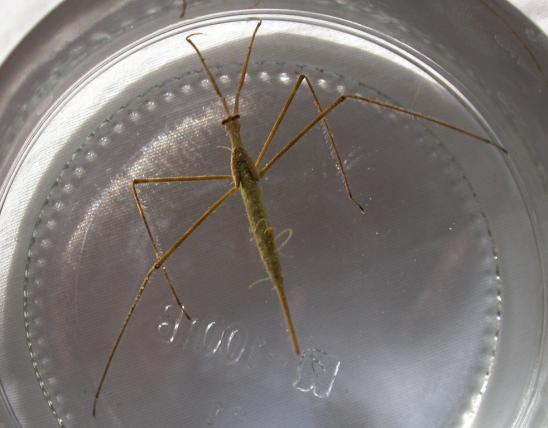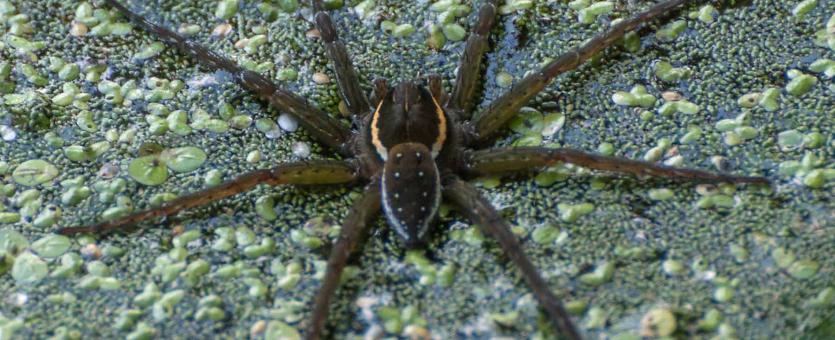
A variety of spiders are adapted for life on and around water. Many of these are commonly called fishing spiders or water spiders. Several have the ability to run across the water’s surface. Some build webs, while others do not. Below are two of our most common types of aquatic spiders.
The spotted fishing spider (Dolomedes triton, in family Pisauridae) lives in aquatic habitats and can run across the surface of water. This long-legged, dark-colored running spider is also distinctive in that the oval abdomen is smaller than the broad cephalothorax (“head”). A whitish-yellow stripe surrounds the dark carapace and sometimes also the abdomen. On top of the dark brown abdomen, pairs of minute white spots create a connect-the-dot pattern or run down the middle of the back. The legs are robust and brown, dotted with white hairs. This spider runs quickly. Missouri has several other species of fishing spiders in genus Dolomedes, too, including the striped fishing spider (D. scriptus), whitebanded fishing spider (D. albineus), and dark fishing spider (D. tenebrosus); the latter two are less strongly associated with aquatic habitats.
Longjawed orbweavers (family Tetragnathidae) are often called “stretch spiders” because they often rest with their two front pairs of legs stretched straight out in front of them, and the last pair outstretched behind. Combined with their slender bodies and drab, variably marked coloration, they can hide easily while clinging to a blade of grass. They spin circular webs that are usually positioned fairly horizontally within a few feet of the water’s surface.
Similar species: Water striders (striders, not spiders) “stride” across the water surface and are sometimes seen in rather large groups. They are not spiders at all; instead, they are in the order Hemiptera (the “true bug” family of insects) so they are related to assassin bugs, water scorpions, assassin bugs, water boatmen, and stink bugs. Like other insects, they are easily separated from spiders by having 6 (not 8) legs.
Also keep in mind that many kinds of land spiders live near water: land habitats near water are places where insects abound and where vegetation is lush and abundant, drawing more insects and providing places for spiders to hunt. See the Land Invertebrates section of this online field guide to learn more about them.
Size varies by species.
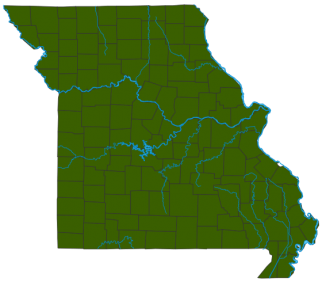
Statewide.
Habitat and Conservation
Fishing spiders (genus Dolomedes) live around ponds, slow-moving streams, swampy areas, and other damp places. They are able to run across the surface of water much like water striders and will dive for prey, including small tadpoles or aquatic insects. A spider in this group can encase its body in an air bubble in order to submerge itself, often for several minutes.
Longjawed orbweavers typically live in vegetation along a water’s edge — in shoreline shrubs whose branches overhang ponds, lakes, rivers, and streams, usually in shady places. They often live along the sides of docks and piers, too. They spin circular (orb) webs that are usually positioned fairly horizontally within just a few feet of the water’s surface, making them perfect nets for catching aquatic insects that have just emerged in their winged adult forms: mayflies, midges, stoneflies, and so on. When not in their web, many longjawed orbweavers hide under branches, railings, or other sheltered locations nearby. If they are startled, they typically drop immediately down. If they fall into the water, they can run across the surface like fishing spiders and water striders do.
Food
Different groups of spiders have different feeding behaviors. Web-building species ensnare insects, especially flying insects, in their webs, bite them to deliver an immobilizing dose of venom, then wrap them in silk to be eaten safely when the spider is hungry. Other types of spiders do not build webs; these spiders (including fishing spiders) usually run, walk, or stand still and wait for prey to come near; then they pounce on the prey, bite it, and eat it. Fishing spiders mostly eat aquatic insects, but they can also feel the struggling vibrations of terrestrial or flying insects when they fall accidentally in the water. Then, they run across the water to snatch the insect. Fishing spiders may eat tadpoles and tiny fish, too.
Status
Common in the appropriate habitats.
Life Cycle
As a general rule, spiders in temperate areas hatch from eggs in spring and spend the growing season eating, maturing, mating, and laying eggs. Female spiders are usually much larger than males and sometimes eat the males after mating. Females continue creating egg cases as long as the weather holds out. As temperatures cool in fall, their metabolism slows, and they generally die when it freezes. Egg cases overwinter, and spiderlings hatch in spring.
Human Connections
Some of the most “buggy” places in Missouri are in lowlands near water. This is where hosts of flying insects, many obnoxious to people, congregate and reproduce. Spiders that build their webs over the water help to keep the numbers of these flying insects in check.
A great many insects live in the water, including young mosquitoes, and fishing spiders that hunt on the water’s surface help control insects at that level, too.
Aquatic spiders are eaten by many species of fish, including bass, sunfish, catfish, and trout, so anglers can appreciate them for this reason, too.
Ecosystem Connections
Spiders control populations of the many kinds of insects and other small animals they prey upon. In addition to the many fish that eat aquatic spiders, birds, amphibians, and reptiles also catch them. These (and many other spiders) are also stung and collected by certain wasps, which provision their nests with the comatose spiders, to provide food for their larvae.
You might have heard of a "diving bell spider" that spends its "whole life" underwater; this is species Argyroneta aquatica, which is found only in Europe and Asia. It weaves silk webs underwater that hold bubbles of air that the spider uses to breathe for long periods of time while under water.
One interesting predator of fishing spiders (Dolomedes spp.) is a blue-black spider wasp called Anoplius depressipes. This wasp has specialized flattened front feet that are fringed with hairs, which allow it to walk on water just like its prey. When transporting a spider, this wasp grasps the spider with its middle or hind legs, faces forward, then extends its forelegs and uses them like water skis while it propels itself and its prey across the top of the water, beating its wings. This spider wasp sometimes dives down into water to chase its prey, since water spiders often swim underwater when frightened.



